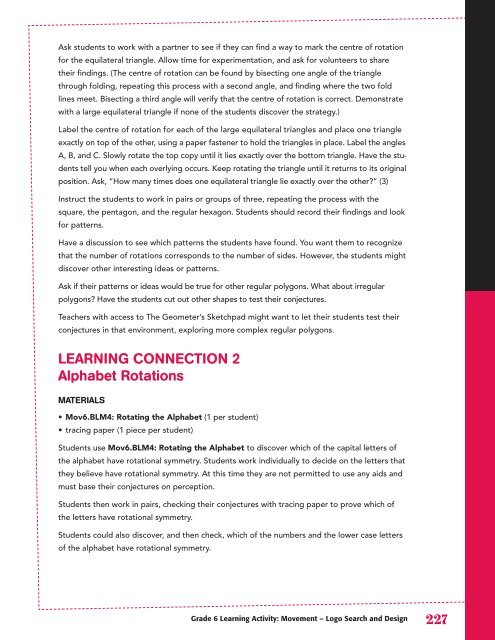Geometry and Spatial Sense, Grades 4 to 6 - EduGains
Geometry and Spatial Sense, Grades 4 to 6 - EduGains
Geometry and Spatial Sense, Grades 4 to 6 - EduGains
Create successful ePaper yourself
Turn your PDF publications into a flip-book with our unique Google optimized e-Paper software.
Ask students <strong>to</strong> work with a partner <strong>to</strong> see if they can find a way <strong>to</strong> mark the centre of rotation<br />
for the equilateral triangle. Allow time for experimentation, <strong>and</strong> ask for volunteers <strong>to</strong> share<br />
their findings. (The centre of rotation can be found by bisecting one angle of the triangle<br />
through folding, repeating this process with a second angle, <strong>and</strong> finding where the two fold<br />
lines meet. Bisecting a third angle will verify that the centre of rotation is correct. Demonstrate<br />
with a large equilateral triangle if none of the students discover the strategy.)<br />
Label the centre of rotation for each of the large equilateral triangles <strong>and</strong> place one triangle<br />
exactly on <strong>to</strong>p of the other, using a paper fastener <strong>to</strong> hold the triangles in place. Label the angles<br />
A, B, <strong>and</strong> C. Slowly rotate the <strong>to</strong>p copy until it lies exactly over the bot<strong>to</strong>m triangle. Have the stu-<br />
dents tell you when each overlying occurs. Keep rotating the triangle until it returns <strong>to</strong> its original<br />
position. Ask, “How many times does one equilateral triangle lie exactly over the other?” (3)<br />
Instruct the students <strong>to</strong> work in pairs or groups of three, repeating the process with the<br />
square, the pentagon, <strong>and</strong> the regular hexagon. Students should record their findings <strong>and</strong> look<br />
for patterns.<br />
Have a discussion <strong>to</strong> see which patterns the students have found. You want them <strong>to</strong> recognize<br />
that the number of rotations corresponds <strong>to</strong> the number of sides. However, the students might<br />
discover other interesting ideas or patterns.<br />
Ask if their patterns or ideas would be true for other regular polygons. What about irregular<br />
polygons? Have the students cut out other shapes <strong>to</strong> test their conjectures.<br />
Teachers with access <strong>to</strong> The Geometer’s Sketchpad might want <strong>to</strong> let their students test their<br />
conjectures in that environment, exploring more complex regular polygons.<br />
LEARNING CONNECTION 2<br />
Alphabet Rotations<br />
MATERIALS<br />
• Mov6.BLM4: Rotating the Alphabet (1 per student)<br />
• tracing paper (1 piece per student)<br />
Students use Mov6.BLM4: Rotating the Alphabet <strong>to</strong> discover which of the capital letters of<br />
the alphabet have rotational symmetry. Students work individually <strong>to</strong> decide on the letters that<br />
they believe have rotational symmetry. At this time they are not permitted <strong>to</strong> use any aids <strong>and</strong><br />
must base their conjectures on perception.<br />
Students then work in pairs, checking their conjectures with tracing paper <strong>to</strong> prove which of<br />
the letters have rotational symmetry.<br />
Students could also discover, <strong>and</strong> then check, which of the numbers <strong>and</strong> the lower case letters<br />
of the alphabet have rotational symmetry.<br />
Grade 6 Learning Activity: Movement – Logo Search <strong>and</strong> Design 22

















